 By Tim Heston, Sr. Editor
By Tim Heston, Sr. Editor
December 2020 issue
How Pennsylvania metal fabricator cuts with ultrahigh laser power
The business case requires process reliability and a holistic view when it comes to putting power
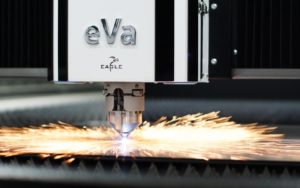
One Pennsylvania metal fabrication shop has two laser cutting machines—nothing out of the ordinary, until you realize they have 15 and 20 kW of cutting power, respectively. Images provided
The metal fabrication industry’s business case for high laser cutting power has evolved over the years. In the early years of CO2 laser cutting, more power let you cut faster and thicker. Especially for custom fabricators, a higher-powered laser broadened a shop’s capabilities, which in turn opened the door to new customers and markets.
Then in the late 2000s came the fiber laser and a whole new ballgame. Cutting thin stock, a fiber laser could run circles around a similarly powered CO2. The fiber laser pushed the industry’s cutting capacity skyward, so much so that many shops struggled to feed the beast. Sure, a shop could automate the material handling, but even so, a laser that cuts extraordinarily quickly can overwhelm processes downstream, especially bending and welding. It’s about order-to-ship throughput: If a shop beefs up its cutting capacity only to shove the bottleneck downstream, what good is all that cutting power?
Turns out, all these assumptions might oversimplify the chess-like strategy needed to foster optimal throughput, especially once you take a deep dive into operations that have installed 10, 15, even 20 kW of fiber laser cutting power.
A prime example, Raytec LLC has found plenty of good in more cutting power. On the shop floor sit two fiber lasers, one 15 kW and the other 20 kW. To understand why the fabricator invested in such immense cutting power requires a closer look at the throughput chessboard.
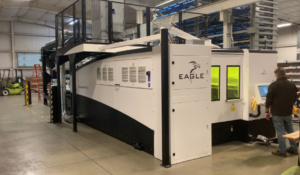
The 20-kW Eagle faces this 15kW Eagle Laser at Raytec LLC.
Not Just for Bragging Rights
Glen Zimmerman, one of Raytec’s owners, had been eyeing high-powered laser cutting for years. “In laser cutting, you need to stay current or you’re going to be out of the game,” Zimmerman said. “Technology is evolving so rapidly.”
He wasn’t eyeing high laser power for bragging rights, but because the technology fit the shop’s overall growth strategy. Zimmerman’s grandfather founded Raytec as a small fab shop in 1956 (the shop is named after Zimmerman’s father, Raymond). The company grew by offering products for the building and agriculture industries, from residential gutter components to specialized carts used at dairy and pig farms.
As the company’s collection of CNC fabrication equipment grew, so did its demand for job shop work. Today the company’s New Holland, Pa., plant produces a mix of job shop work as well as sheet metal parts for its own product lines. A plant in nearby Ephrata and a location in Missouri perform stamping and roll forming for the company’s building product lines.
The New Holland plant, which serves all three businesses—building products, ag products, and job shop work—has limited space. Getting the most throughput out of that space has driven the shop’s equipment investment strategy since it bought its first CO2 laser cutting machines in the late 1990s. It replaced those with a 4-kW fiber laser in the 2010s. And then in 2019 the shop made its first plunge into ultrahigh laser power, purchasing a 15-kW fiber laser. In 2020 the shop followed that up with another fiber laser, this one all of 20 kW. Both are Eagle laser systems.
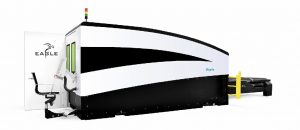
The Cutting Head Barrier
In sheet and plate cutting, the fiber laser itself hasn’t been the constraint. Eye-popping fiber laser power has been around for years, being used in specialized welding, military, and other applications. The constraint has been the laser cutting machine itself, specifically the laser cutting head.
The cutting head has been ultrahigh-power laser cutting’s Achilles’ heel. A machine might have a solid frame, linear drives, and very high cutting speeds, but all those advantages go out the window if a shop keeps blowing cutting heads. And it’s usually not for lack of maintenance. Extraordinarily high-power laser beams need extraordinarily clean optics. The smallest imperfection—like infinitesimally tiny debris that falls from a moving component within the head—can cause heat to build up uncontrollably. Similarly, continually replacing the protective cover glass doesn’t help cleanliness or throughput either; cover glasses aren’t free.
The latest cutting heads are changing the game, however, which is one big reason that more and more 10-kW-plus machines are reaching the market. “We had been watching the high-powered laser for years,” Zimmerman said. “We knew some shops were starting to dabble with machines 12 kW and above, but we also knew that they had trouble with the cutting heads.”
The Eagle machines on Zimmerman’s shop floor have no moving parts within the beam path in the head, and the collimation components are positioned outside the head itself. The cover glass is also recessed far inside the head cavity. Debris from piercing or cutting must make its way 14 in. through a downflow of assist gas to reach the protective glass window.
Finally, there’s the beam’s energy density that, the machine manufacturer states, is decreased by the large optical elements. “When we looked at these fiber lasers, we analyzed how much stress is going through the cutting lens,” Zimmerman said. “With these new machines, we see they can put 15 kW through an area with less energy density that our older 4-kW fiber laser had.”
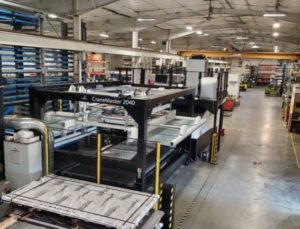
Raw stock is staged for laser cutting. Work flows quickly from blanking to bending and hardware insertion on the far side of the plant.
The Business Case
When people think of ultrahigh-powered fiber lasers, they automatically think of thick stock. But as Zimmerman explained, that’s not why Raytec jumped into the fray of double-digit-kilowatt laser cutting. Sure, the company has cut 0.75-in. stock, and it’s experimenting with gas mixes and laser parameters to make its thick plate cutting even more effective, but that’s not why the fabricator has two ultrahigh-power machines.
Raytec’s market for ultrathick-plate laser cutting is small, at least relative to the 0.25-in.-thick-and-less market. Of course, the shop could establish a strong niche, perhaps take work away from other thermal cutting operations that, because of critical edge requirements, follow up with edge machining. If a laser can eliminate a machining step, it can save a customer a lot of money.
These niches can diversify a shop’s job portfolio, but the demand for such cutting might not be enough to be a primary revenue driver. As Zimmerman explained, the throughput potential drove the operation toward such high-power machines. The two new lasers give Raytec tremendous cutting throughput—the ability to cut more in less time, especially in material 0.25 in. and thinner—allowing the shop to quote work extremely competitively. They also give shop ample capacity both for work that requires downstream forming and hardware as well as cut-only work. The increased throughput changes the cost and price equation, which in turn could bring more work into the laser cutting fold.
Operational Factors
Of course, the business case makes sense only if the operation can indeed increase throughput. Like a finely tuned race car, a fab shop with ultrahigh-powered laser cutting needs every operational variable tuned for maximum throughput and material yield.
Can We Fill a Sheet? “It starts with communicating with your customer,” Zimmerman said, especially when it comes to sheet and plate utilization. Work that fills a standard sheet size increases material yield and can save the customer money while simplifying part flow and remnant management.
Raw Material Purchasing. Such communication carries over to raw material purchasing. Laser cutting, as with all thermal cutting, releases residual stress in the sheet, and parts could bow or distort in some way. Technology in the laser cutting machine can prevent such bowing from hindering throughput (as described later), but no laser cutting machine can change the physics of sheet metal and plate.
As Zimmerman explained, if severely bowed pieces required leveling before being sent to downstream processes or to the customer, that secondary operation would add costs and hinder optimal throughput. All the cutting speed in the world doesn’t matter if a piece requires a leveling step or a serious amount of rework.
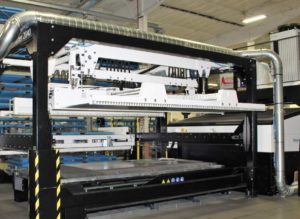
Two ultrahigh-power lasers do have loading automation; part offload is handled by conventional techniques.
Edge Quality, Power, and Assist Gas. The same argument goes for flat-part deburring. Raytec does have a flat-part deburring machine, and as Zimmerman explained, some jobs require edges the laser and punch just can’t produce on their own. But these are the exception, not the rule. Cutting operations minimize the need for deburring with beam control and highly controlled speed around corners and contours; the machines’ cutting head is driven linearly, not with rack and pinions.
The shop also makes strategic use of assist gas, using either straight nitrogen or, for thick stock (7 ga. and thicker) normally susceptible to dross, a carefully controlled blend of nitrogen and oxygen. The nitrogen evacuates the molten material and allows the laser to maintain its speed, while the oxygen provides a burning action that, when tuned correctly, can leave a clean edge.
As Zimmerman said, “When you reach enough laser power, you can start doing unique things with blended assist gas that won’t have the same effect when you have half the laser power.”
Cutting Performance. Although cutting inches per minute still plays a role in throughput, IPM is still only a piece of the puzzle, and it’s one that has to be viewed in a broader context. A cutting head’s speed in a straight line is one thing, but what about corners and contours? How about the piercing cycle and, for that matter, overall process stability?
Here, Zimmerman said, is where linear drives play a role. The two Eagle systems have linear drives in X, Y, and Z. The X and Y allow for high acceleration, all of 6 Gs, according to the machine manufacturer. Quick acceleration means quick cut-to-cut traverse times, of course, but it has another implication for ultrahigh-power laser cutting: the use of full laser power (and, hence, maximum speed) through a greater portion of the entire nest.
If a slowly accelerating head cuts long, straight kerfs on a sheet, it has enough time to accelerate to full speed and make full use of its laser power. But if that same head spends most of its cutting cycle accelerating and decelerating within each cut as it negotiates through intricate patterns and holes, it never reaches its maximum IPM for the material thickness and grade it’s cutting, so (at least from a cutting speed perspective) there’s no need for such a high level of laser power.
And as Zimmerman noted, the quick motion of a linear Z axis is especially important. First, it allows the head to pierce higher on some hole geometries and then immediately drop down to cut.
“It’s also a big deal with part tip-ups and preventing head crashes,” Zimmerman said, adding that sensors on the head (and via other head design attributes) sense part touches and tip-ups quickly. Once the head senses such process instability, it stops immediately and rises instantly. “It then automatically recenters itself and, if it can, corrects the problem and keeps going, continuing where it left off.”
The head has several more crash protection safeguards beyond capacitive sensors, each of which kicks in depending on the nature of the collision hazard. Regardless, Zimmerman said, when laser cutting so fast, having high levels of crash protection is critical to maintain process stability and maximum throughput.
Material Loading and Part Offloading. As fiber laser cutting machines become more and more powerful, “feeding the beast” becomes a greater concern, hence the need for automated material feeds with a fast pallet change. Zimmerman said the shop invested in an automated loader/unloader but not a complete tower storage system (though Raytec has an alternative solution in the works). The floor space is at a premium, and besides, “when you think about it, feeding the system is the easy part. Offloading and part sorting is a different animal.”

Raytec has a mix of bending technologies, including a CNC folder, several press brakes, and (pictured) a TRUMPF cell consisting of an automated press brake dedicated to small parts.
According to Zimmerman, Raytec’s part mix is such that automated or robotic part sorting isn’t an option, at least currently. (The shop does, however, heavily utilize sorting automation for punching, as will be discussed soon.) Also, as laser cutting machines reach extreme speeds, cutting cycle times are extremely short. In other words, at least for Raytec’s operation, automated part sorting would create a bottleneck. So now the lasers offload to a separate table where a team denests the sheet using traditional methods.
That said, Zimmerman knows that chaotic part sorting can be a bottleneck, too, and a severe constraint on throughput, especially if poor sorting leads to lost or damaged parts that need to be recut. This is where strategic nesting comes into play.
First, the shop minimizes nests with remnants. Again, this occurs through good customer communication (adjusting an order so it fills a sheet) as well as through strategic use of filler parts made to stock, either for consistently ordered job shop work or pieces for Raytec’s own product line.
Next comes the actual nesting strategy, a balancing act between high material yield, optimal process stability, grain restraints for bending or cosmetic reasons, and, again, ease of part sorting. Tabbing in the right place helps keep parts secure and prevent them from creating a head-crash hazard. On the other hand, excessive tabbing—either using too many, making them too thick, or both—can make part denesting a bear.
In fact, the absolute ideal for cutting efficiency, material yield, and sorting ease is common-line cutting with no tabs at all. According to Zimmerman, edge quality problems on two common-cut parts usually aren’t an issue, but skeletal integrity can be a problem. So programmers common-cut where they can; nest with web sections when needed; orient parts’ longer dimension perpendicular to the slats so the parts stay stable even without tabbing; and, finally, tab only when necessary.
Operators also observe the cutting action and, if needed, adjust tabbing in the program directly on the machine control. “On the new machines, the operator can actually add tabs to features that didn’t have any,” Zimmerman said, “and effectively remove tabs from other features right at the controls, on-the-fly.”
Operators can also adjust a tab’s thickness. Zimmerman said that for the most part, operators choose to make tabs more robust to ensure process stability; the potential for a head crash is far worse than a slightly less efficient denesting process. But programmers also make sure they don’t overuse tabs and make the shake-and-break harder than it needs to be.
Skeleton cutting also plays a role. Skeleton cutting is standard practice on oxyfuel and plasma tables cutting thick plate; it’s a faster way to remove scrap, and it doesn’t tie up a crane. For lasers cutting sheet or thin plate, it’s been a different story—until, that is, extreme cutting speed has made those extra inches of kerf, made to chop up the skeleton, essentially irrelevant. Again, because ultrahigh-powered lasers are so fast, cutting portions of the skeleton—making both denesting and scrap collection easier—becomes a no-brainer.
Part Identification. A lost part doubly hinders throughput. The operation spends time cutting the part, looking for it, and possibly recutting it if it’s not found. For some jobs at Raytec, a slight change in hole location might be all that differentiates one part from another.
The operation tackles part identification on several fronts. First, it laser-marks parts on the machine when it can. Second, Raytec doesn’t rely only on laser cutting for its blanking needs. It also has a fully automated Prima Power punch/shear. Some of this has to do with formed features like embosses that only punch tooling can create. The punch/shear has integrated tapping as well. But it also has to do with part identification challenges that, as Zimmerman explained, the punch/shear’s automated sorting helps overcome. True, parts are sent down one of four chutes; they aren’t stacked neatly. Regardless, the parts are separated automatically from the scrap, which itself is cut and sent to a final bin for recycling.
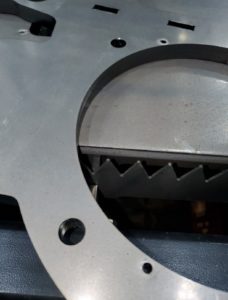
This 0.75-in.-thick part in the as-cut condition was laser-cut with a nitrogen-oxygen blended assist gas.
“That machine processes a lot of parts where, when you glance at them, you can hardly tell them apart,” Zimmerman said. “The hole locations are just so similar. But [on the punch/shear] with automatic separation, we don’t have to worry about sorting these parts.”
Forming Capacity. Raytec does have spot welding and hardware insertion, but the New Holland facility does not have a welding department, which is a common constraint in the cut-form-weld-grind-finish-ship cycle. The company does offer forming with five press brakes; one CNC folding machine; and its most recent and largest forming investment to date, a TRUMPF robotic forming center tailored for small-parts bending.
“This allowed us to take the tedious, time-consuming small parts out of our other press brakes and completely automate our small-parts-bending operation,” Zimmerman said. “It’s been a life-saver for our small-parts forming. We’re running that thing 24 hours a day.”
He conceded that, yes, with the shop’s tremendous cutting capacity, bending still is the constraint operation, but the mix of forming technologies makes that constraint much less severe. In fact, both the automated small-parts bending and the folder take away the least productive work on the conventional CNC press brakes. Thanks to the folder, brake operators need not struggle to support a large part as it swings up to make a narrow flange; thanks to the robotic brake for small parts, they also need not tie up a wide press brake bed with a narrow punch and die set to bend small bracketry.
The mix of forming technology helps keep the flow. And with so much blanking capacity, the company could add even more press brakes and other forming equipment to boost throughput even more.
2020: Not So Bad After All
“Back when the pandemic started, we weren’t sure what to expect,” Zimmerman said. “Our natural inclination was to pull back, because bad things were going to happen with that much market disruption. But we’ve experienced the opposite. For pretty much all of the business segments we serve, it’s just been crazy busy. In fact, some months we were pushing 40% year-over-year growth.”
By the end of the year, 2020 revenue could exceed 2019 revenue by between 20% and 25%. The New Holland plant employs only 15 people, and the company has 46 employees across all facilities.
“We feel very fortunate and blessed. And we were so glad to have the equipment we have. We were able to increase throughput without having to increase labor.”
That in a nutshell has been the story of metal fabrication: Increasing throughput (sales) per employee makes each employee more critical to the shop’s success, and technology has given those employees the tools to make that success happen.
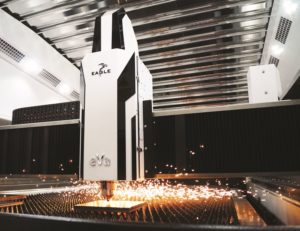
A 15-kW laser at Raytec LLC performs a pierce. To protect the sensitive optics from spatter, the cover glass is recessed 14 inches.